Chełmno
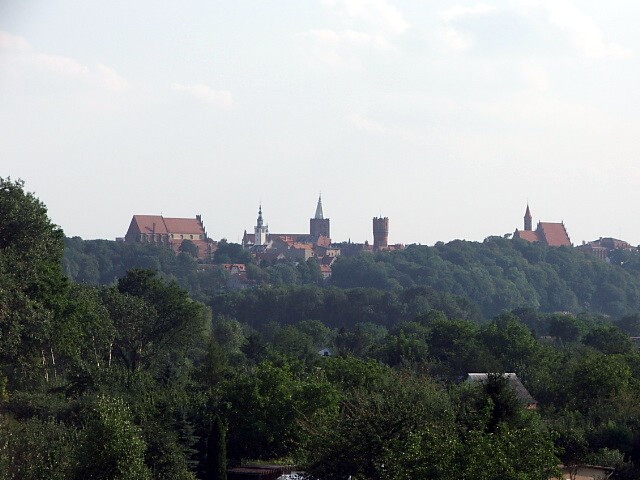
Chełmno. View of the city towers and peaks from Wisła’s eastern river bank, north of town.
Distance
Population
20.822 (2007)
Location and history
Chełmno is located in the Kuyavian-Pomeranian county, on Wisła’s right (eastern) broad – high above the river, approximately midway between the three major cities: Bydgoszcz (to the southwest), Toruń (to the southeast) and Grudziądz (to the northeast). The river Wisła, which, at the level of Bydgoszcz, describes an arch to the west, runs at Chełmno in a northeastern direction. Highway # 1, which leads from Cieszyn at the Czech border to Gdańsk, passes Chelmno’s eastern outskirts and leads across Wisla on a bridge north of town; On the west side of the river, Highway 1 continues to the northeast, while No. 5 leads southwest, towards Bydgoszcz.
The town name Chełmno comes from the Slavic word chełm, which means a hill or high. A similar meaning has the Latin term for the city: Culmen and the German name: Kulm, both of which denote a height or mountain peak. The first mention of the place name dates from the 11th century, at which time it appeared in the local, Slavic form: Chołmien. Chelmno can thus be translated as: the city on the hill.
History:
The Chelmno area has been part of the Polish state all the way back to Prince Mieszko I’s time (ca. 922-992), where it was a border area adjacent to the land of the Prussians. The oldest Chełmno was a settlement located on the hill, now called Góra św.Wawrzyńca, in the village of Kałdus, ca. 3.5 km southwest of the current city. The fortified buildings on the site had defensive significance from the 12th century. At the present site of violence, one can see that within the fortress ramparts there has been a significant sacral structure. The Polish prince Konrad I Mazowiecki (c.1187-1247) tried to force the Prussian tribes or at least prevent them from entering the Chełmno area. He was unsuccessful and in that connection, the Chełmno fortress was destroyed. Then in 1226 he called the Crusader order to the Chełmno area with the aim of fighting the Prussians while retaining Polish supremacy over the areas where the Crusaders settled and the areas which they conquered. This was unsuccessful either, but the Prussians were defeated. Hermann von Balk, the leader of the Order's battles against the pagan Prussians, was given the title of Surveyor of Prussia (by the word Prusija (Lithuanian) / Prusy (Polish), ie the country of the Prussians) and he chose to place his office on the altitude where now the village of Starogród is located, approx. 6 km from the current city. Here was built a new castle and a city. The Order of the Crusader Grand Master Hermann von Salza and the Mayor Hermann von Balk granted the newly founded city a number of privileges. This document, called the Chełmno privileges, also applied to the city of Toruń; they were a modification of the widely used Magdeburg, as well as the Flemish and Hungarian privileges, and they became the pattern of the township schemes in the cities that were subsequently founded in the Crusader state as well as several cities in Poland. These privileges envisaged the building of Chełmno as the provincial capital. The Chełmno privileges were very extensive and detailed, and they provided a good basis for the economic development of citizens and the city, for the development of trade and culture and the state of law in the city. In 1239, the Crusaders – again – moved the city to a location further to the north, namely to what is now called Rybaki and constitutes the oldest (and to some extent dilapidated) district in Chełmno, northwest of the present center. Finally, in 1251, Chełmno was founded on its present location. No castle was built in connection with this new and final location, but a fortified house was erected in the north-west corner, with the order's comet in it “new” Chełmno resided. The remains of this building (Mestwina Tower) are found today in the monastery area.
In the 13-14th year. the city flourished and the basis for its significance and fame was laid, i.a. via the extensive transit trade. Merchants from Western countries: German, English, Dutch and Danish etc. settled in the city and actively contributed to the development of the city. A market privilege was granted by the Order of the Crusader in 1298. Between 1300 and 1443, the city was an active member of the Hanseatic League. A privilege granted by the pope in 1386 allowed the establishment of a university.
In 1410, Chelmno took part in the Battle of Grunwald. The thirteen-year war of 1454-66 ended with (the second) peace settlement in Toruń, whereby the Chełmno country returned to Poland. In 1457, the city was conquered by military commander Bernard Szumborski (Bernard von Zinnenberg), who was in the service (mercenary) of the Crusader Order. When he was not paid wages by the order, he retained Chełmno and other conquered cities and castles as a mortgage, and Chełmno remained occupied until 1479. The occupation meant a financial setback for the city.
In 1473, a college was established on a par with a higher secondary school, which was later transformed and renamed: Akademia Chełmińska – Chełmno Academy.
From 1505 the town was ruled by the Chelmno bishops. In the 16th and 17th centuries, the economy is flourishing again. Several Dutch and Scots settle in the city.
The 18th year. is largely a downturn due to several wars and an epidemic at the turn of the century, as a result of which the population dropped drastically. In the second half of the 18th year. the Chełmno Academy became a branch of the Jagiełło University in Kraków. In 1772 – at the first division of Poland, Chełmno came under Prussian rule.
1807-1815 Chełmno lay within the Principality of Warsaw’s limits.
In 1850 the local newspaper “Nadwiślanin” founded.
In 1880 and 1881, physician Ludwik Rydygier, who had a private clinic in Chelmno, performed two complicated abdominal operations on a cancer patient (1880) and a gastric ulcer patient (1881). Rydygies were the first (1881) and the second (1880) in the world to complete this type of operation, respectively.
In January 1920, Chełmno was liberated by the Polish army under the command of General Józef Haller.
At the outbreak of World War II and the German occupation of the country, the occupying forces carried out mass arrests and executions of the people of Chełmno and the surrounding area. In January 1945, the city was liberated by soldiers from the 2nd Belarusian Front.
After the war comes another positive period of economic development; new industrial companies are emerging and new residential neighborhoods are being built. In 1963, the road bridge was built over Wisła.
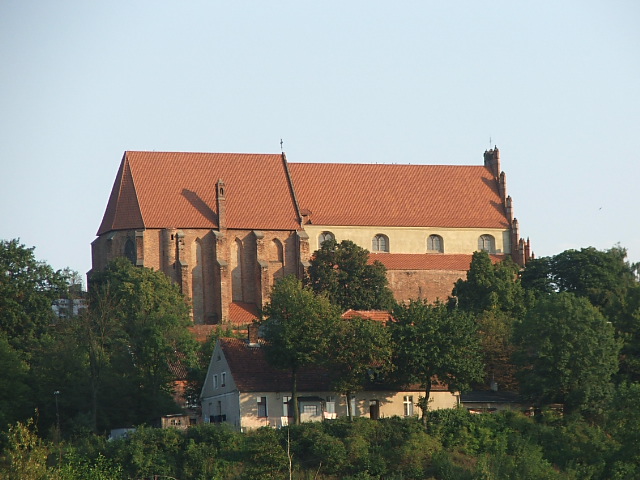
Dominican Church in Chełmno
Tourist attractions
Attractions:
Chełmno is one of the most beautiful cities in northern Poland; The city has a rich history that spans several centuries, and a well-preserved city center with city walls and churches. The city's location on the outskirts of the Wisła Valley provided the good conditions of defense in the Middle Ages. The old city within the city wall is an example of a medieval urban structure that emerged in a new place and based on a detailed plan that had been prepared in advance.
In the plan for the new city, the whole was divided into four quarters or neighborhoods. A rectangular square was planned in the city center. The central building on the square was the town hall. In the planning, a special scale was used: pręt chełmiński, which was equal to 4.35 m. The width of the streets, for example, was planned for 2.5 pręta chełmińskiego, ie. ca. 11 meters.
The fortification of the city : the city wall, fortress towers, city gates, the powder tower.
The city wall has been preserved to almost all its extent and today measures a total of 2,270 m; the wall delineates the flat area at the top of the ridge where the city was built in its time. The brick-built fort was built from the middle of the 13th century. to the middle of the 14th century. instead of the original fortifications of wood and earth. In the 14th to 16th centuries. the wall was raised and expanded, i.a. after the Swedish wars in 1678. In the second half of the 19th century. two sections of the wall and 5 gates were demolished to facilitate internal communication in the city. At the end of the 19th century. conservation work began on the wall.
Initially there were 25 or 27 fortress towers built into the wall; some were watchtowers open to the city; Of these, 17 are fully preserved while 6 are only partially preserved.
City gates: At the ends of the city's main streets, there were 7 gates in the city wall. To the east, the wall was further secured with a moat. The main access to the city was from the northeast through the Grudziądz gate, which continued in the Grudziądz street; to the south was Brama Tkacka (Weaver Gate), and traffic through this gate continued through the city along Tkacka Street (today ul. 22-Stycznia). Both of these gates stood by the moat and in their time were equipped with a gutter bridge. The other gates were the Wodna Gate to the southeast (at the end of the Wodna Street), to the south Toruń Gate, to the southwest Brama Mostowa (at ul.Szkolna), to the west the Franciscan Gate and to Brama Merseburska. Today, only Brama Grudziądzka and Brama Merseburska are preserved, and the latter only partially, as it was already in the 14th century. lost part of its importance, was walled to and furnished to chapel.
Brama Grudziądzka was built at the end of the 13th century. Around 1620, a chapel was called upstairs called “After Bramce“associated with the cult of Godmother of Chełm.
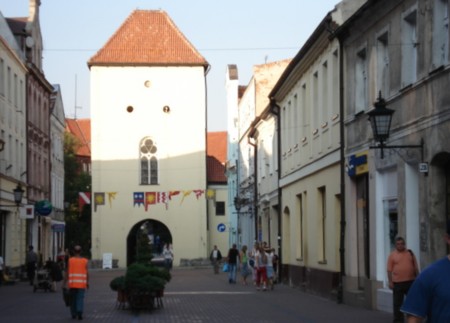
The Grudziądz gate at the end of the Grudziądz street
Among the many fortress towers are the Baszta Panieńska (Virgo tower), Baszta Prochowa (Powder tower) and the aforementioned Mestwina tower.
Baszta Prochowa (Powder Tower) was erected at the transition between the 13th and 14th centuries, originally as an open tower, which was closed in the 15th century. In the Middle Ages, the tower was used as a magazine for military equipment and as a place of manufacture for gunpowder. It is now a regional museum with a permanent exhibition about the city of Chełmno’s and the surrounding history.
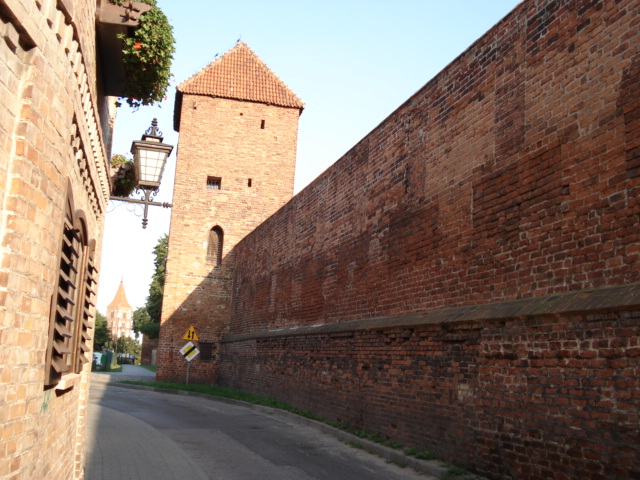
Part of the city wall with Baszta Prochowa (Powder Tower). In the background, the Holy Spirit Church is believed
Since 1999, Baszta Panieńska has been home to an organization that nurtures the medieval knightly traditions, and visitors to the tower can see an exhibition of weapons, costumes and other effects that illuminate this tradition.
Square
In the north-east of the square, in the Middle Ages there were low buildings for trade and crafts, e.g. for making bread and meat products and for the cobbler's craft. In the southeastern part there was a guard building, demolished in the 19th century, water reservoir for fire extinguishing purposes, 3 wells, pumps and water tower. At the square were also grocery stores and houses, e.g. The English House, Arturs Gård (Dwór Artura) as well as the Dutch House and the Danish House.In the course of time, the appearance of the square has changed; the Gothic stone houses have largely disappeared and been replaced by 19th and 20th century civic houses. The square covers approx. 1.5 hectares and from here the main streets of the city. In the middle of the square stands the town hall.
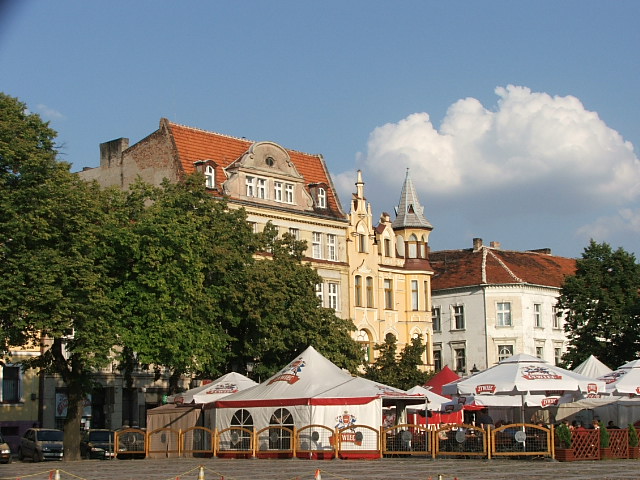
From the square in Chełmno
City Hall .
The town hall is the most important building on the medieval square in Chełmno and at the same time one of the most beautiful examples of Renaissance construction in Poland. It was built in 1567-72 instead of the former Gothic town hall, built around 1298. The tower was built in 1584-96 and crowned by a Baroque-style helmet, made by Krzysztof Wagner of Gdańsk in 1721. The current town hall is in 3 floors with an artfully executed attic. The building has been operating since 1983 in the museum of the Chełmno region, and there are both permanent and changing exhibitions of a local historical character.
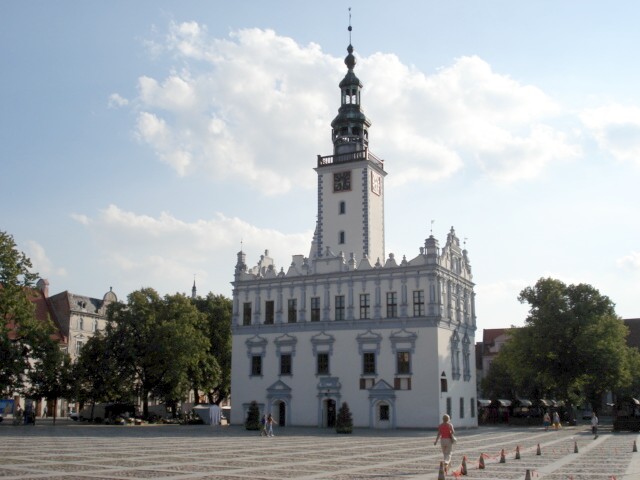
The old town hall in Chełmno, which now houses the regional museum
Churches and monasteries .
Although not a large city, Chełmno has no less than 6 Gothic churches: the Church of the Virgin Mary (Parish Church), the Franciscan Church, the Dominican Church, John the Baptist and the Evangelist John’ Abbey Church, Church of the Holy Spirit and Church of Saint Martin. In addition, there are – or were found – further: the still existing Neoromanian Garrison Church and 2 no longer existing: the Evangelical Church and St. George's Church at the city gate named Brama Sukiennicza (or Brama Tkacka); this last church played in the Middle Ages a role in the isolation of the lepers.
Virgin Mary's Ascension Church (Parish Church) (Kościół Archiprezbiterialny pw. Wniebowzięcia NMP):
This church, which is an excellent work of art in Gothic architecture, was founded by the Order of the Crusaders and is mentioned in the city's letter of privilege from 1233. Already from the 13th century. worked both a school and a library at the parish church. In 1519, the church was granted the status of a collegiate church. Restorations of the church in the 1920s revealed, among other things, murals from around 1400. Originally the church was built of wood. The brick church was erected in several stages in the years 1280-1320. The building of the northern tower was completed in 1501, while the southern tower was never completed. The church is oriented precisely in the east-west direction and consists of an extended, just-completed chorus section, a three-part main ship and a massive west façade with two towers of different height. The interior of the church dates from the Renaissance, Baroque and Rococo times. The main altar is a work by the woodcutter Maciej Rodte from 1708-10 with a depiction of the Virgin Mary's Ascension. Near the choir are two chapels: the north is the Mother of God of Chełmno’Chapel, but the south is the Chapel of the Body of God.
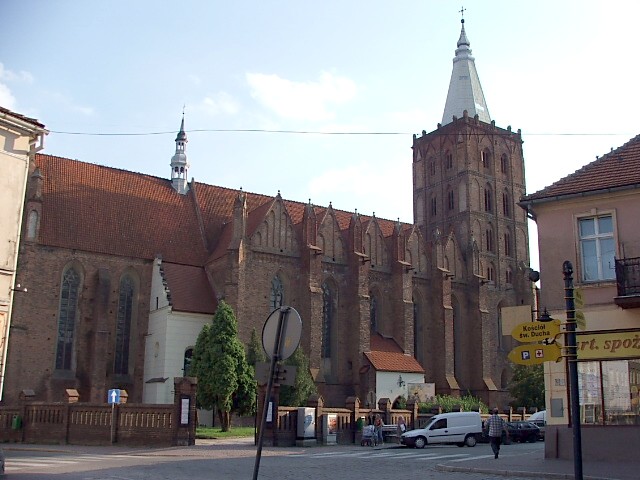
Virgin Mary's Church of the Assumption
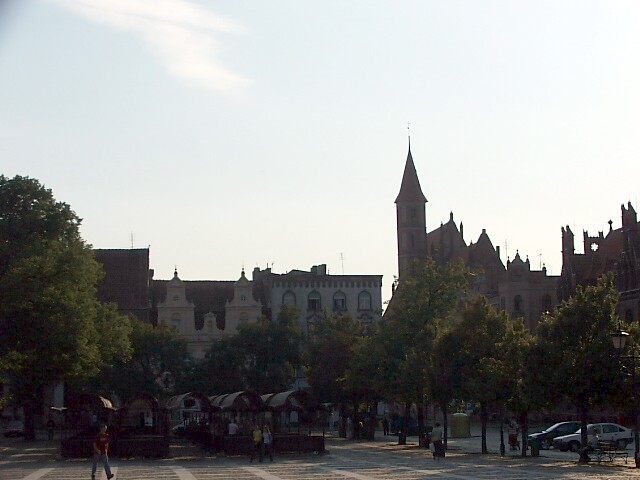
View from the square to the west; th. see the tower of the Franciscan Church
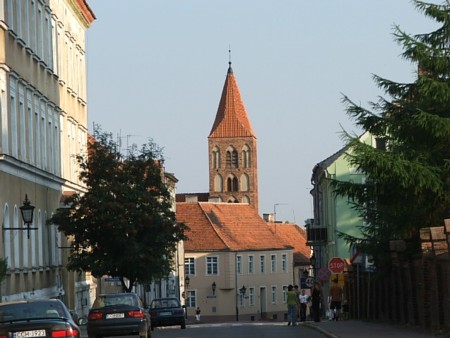
The area southeast of the square with the Holy Spirit Church tower in the background
The former Cistercian / Benedictine-Abbey complex
The Cistercian Nuns settled in Chelmno in 1266. However, the Nuns left the monastery in the first half of the 15th century, after which it was taken over by the Benedictine Nuns. This last order had to be discontinued in 1821 and from 1822 onwards the monastery was run by the Borromeus sisters. The monastery complex originated at the transition between the 13th and 14th centuries. near the Crusaders Fortress Tower, called the Mestwina Tower, by the city wall. The complex includes monastery buildings, hospital buildings, gardens and a church building. The monastery church was located in the northern part of the complex, following the custom of the Cistercians. At the end of the 19th century. there was a significant rebuilding and expansion of the complex. To the northwest of the abbey area stands the aforementioned Mestwina Tower (or Mściwój Tower); it was formerly the residence of the Crusaders' comet as well as the watchtower. The tower is a square brick building. On the second floor there is a large hall covered with plywood vault.
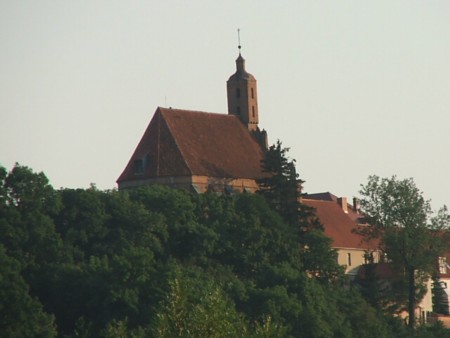
Monastery complex
John the Baptist and the Evangelist John’ Abbey church
belonging to the abovementioned abbey complex is a church of the church, which contains a kind of 2nd floor in the form of an empore (gallery) for the use of the nuns and covered with a star vault. Noteworthy is the stone portal to the south, from 1619. Inside the church are noticed the polychromes uncovered in 1932 from the middle of the 14th century, the pulpit, the main altar, etc.
Streets and houses .
At the recent founding of Chełmno, the city (now the Old Town) was planned as regularly as a chessboard, with all streets – with the exception of those running along the city wall – crossing each other at equal angles. Apart from the city wall and the churches, this street course is the only thing that remains completely unchanged in its original form today. The appearance of the streets, as they present themselves today, has been designed in three stages: during the economic upswing from the 16th to the 17th century, at the transition between the 18th and the 19th years. after the partition of Poland and at the transition between the 19th and 20th centuries, where the city was intensively expanded in an eastern direction. Of the original building, only a few traces remain, thus the house of the Cywiński family (Kamienica Cywińskich).
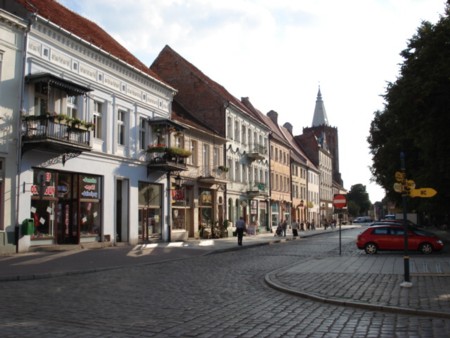
View from the south side of the square to the southwest; furthest away is the parish church tower
Other attractions:
Akademia Chełmińska (Academy of Chełmno), ul. Szkolna 6.
From 1473 a higher education institution was operating in Chełmno; the school's existence was threatened after Poland's first division, and in 1818 the Chełmno Academy was closed. The Academy building now houses the Municipal Gymnasium no.1. The building was modernized in 1998.
Spichlerz (Warehouse), ul. Podmurna 2
This is the most interesting of the city's old warehouses / warehouses, it was erected at the transition between the 18th and 19th century. as a half-timbered structure (which in Poland is called “pruski mur”, i.e. Prussian wall) on a foundation stone and 2 storeys.
Surrounding Area
The scenery in the vicinity of Chełmno is naturally characterized by the proximity of the wide Wisla River.
Kałdus (3.5 km southwest of Chelmno)
Violence with the remnants of the city of Chełmno’s first location.
Starogród (6 km southwest of Chelmno)
Foundations from a crusader castle (the city of Chełmno’s 2nd position).
Wabcz (10 km east of Chelmno)
Gothic church from the 13th century. as well as an early medieval rampage.
Watorowo (6 km south of Chelmno)
The Chelmno fortress from the early 20th century; airbase.
Kijewo Królewskie (9 km south of Chelmno)
Gothic church from the 13th century.
Trzebcz Szlachecki (15 km southeast of Chelmno)
Gothic church from the 13th century; goods and parks from the 19th century.
Grzybno (22 km south of Chelmno)
Gothic church from the 13th to 14th century.
Accommodation
Booking.com
Chełmno The city's official site – in Polish, English, German, French and Russian.
Eating Out:
Chełmno The city's official site – in Polish, English, German, French and Russian.
Other Internet sites and sources
Chełmno The city's official site – in Polish, English, German, French and Russian.
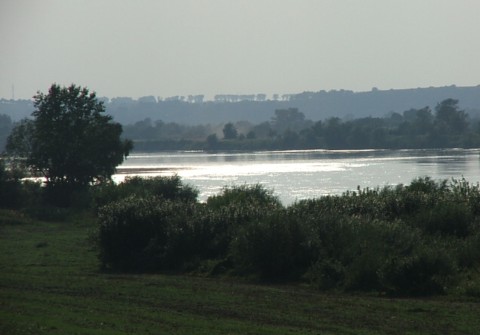
Mood image from the Wisła River north of Chłmno
Translated into English by Google Translate. Spangshus.dk accept no liability for any errors or omissions in translation.
Map
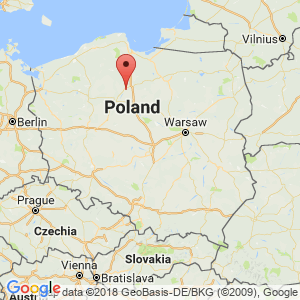
Rating
Search
Most used tags
churches (205) Castles (86) Monasteries (79) Town walls (74) Lakes (71) Town halls (67) Rivers (65) Castles1 (62) Mansions (55) Museums (51) Regional museums (38) Town gates (36) Abbey churches (35) Castle ruins (30) Cathedrals (26) Forests (25) Health resorts (24) Mounds (23) Water sports (23) National parks (22)Click for all tags
Denne side er også tilgængelig på dansk. This page and contents is (c) Copyright 2018- www.spangshus.dk. Based on Inviator software by ISCA Software